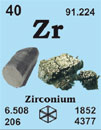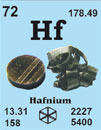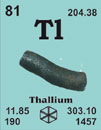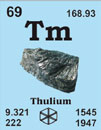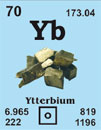Cadmium single crystal 48Cd112.40
Discovered in 1817 by F. Stromeyer at Göttingen, Germany.
[Latin: cadmia = calamine]
French: cadmium
German: Cadmium
Italian: cadmio
Spanish: cadmio
Description: Cadmium is a silvery metal that tarnishes in air, and is soluble in acids but not alkalis. It is used in rechargeable batteries, alloys and pigments, but because of its toxicity these uses are being phased out wherever possible.
Cadmium single crystal properties
| State: |
Single crystal |
|---|
| Crystal structure: |
rhombohedral |
|---|
| Production method: |
Bridgman |
|---|
| Standard size: |
diameter 12
thickness 1-2mm |
|---|
| Orientation: |
(0001) |
|---|
| Orientation accuracy: |
<2°, <1°, <0.4° or <0.1° |
|---|
| Polishing: |
as cut, one or two sides polished |
|---|
| Roughness of surface: |
<0.03 µm |
|---|
| Purity: |
99.999% |
|---|
Further Materials properties
| Crystal structure: |
(cell dimensions/pm), space group, h.c.p. (a=297.94, c=561.86), P63/mmc |
|---|
| X-ray diffractions mass absorption coefficients: |
CuKa 231 (µ/r) / cm2g-1
MoKa 27.5 (µ/r) / cm2g-1 |
|---|
| Neutron scattering length: |
0.51 b/10-12 cm |
|---|
| Thermal neutron capture cross-section: |
2450 sa / barns |
|---|
| Density: |
8.65 kg/m-3 |
|---|
| Melting point: |
320.95 °C / 594.1 °K |
|---|
| Boiling point: |
764.85 °C / 1038 °K |
|---|
| Molar volume: |
13.00 cm3 |
|---|
| Thermal conductivity: |
96.8 [300 K] Wm-1K-1 |
|---|
| Coefficient of linear thermal expansion: |
29.8 x 10-6 K-1 |
|---|
| Electrical resistivity: |
6.83x10-8 [293 K] Wm |
|---|
| Mass magnetic susceptibility: |
-2.21 x 10-9(s) kg-1m3 |
|---|
| Young's modulus: |
62.6 GPa |
|---|
| Rigidity modulus: |
24.0 GPa |
|---|
| Bulk modulus: |
51.0 GPa |
|---|
| Poisson's ratio: |
0.30 |
|---|
| Radi: |
Cd2+ 103; Cd+ 114; atomic 149; covalent 141 |
|---|
| Electronegativity: |
1.69 (Pauling); 1.46 (Allred); 4.33 eV (absolute) |
|---|
| Effective nuclear charge: |
4.35 (Slater); 8.19 (Clementi); 11.58 (Froese-Fischer) |
|---|
| Number of Isotopes (incl. nuclear isomers): |
31 |
|---|
| Isotope mass range: |
99 -> 124 |
|---|
Biological data
| Biological role: |
None has been proved, although suspected. It is stimulatory |
|---|
| Toxicity |
|
|---|
| Toxic intake: |
17 mg kg-1 (chloride, oral, rat) |
|---|
| Lethal intake: |
LD50 (chloride, oral, guinea pig) = 63 mg kg-1 |
|---|
| Hazards: |
Cadmium is toxic but its emetic action means that little is absorbed, so fatal poisoning rarely occurs. Cadmium is carcinogenic and teratogenic. |
|---|
| Level in humans |
|
|---|
| Blood: |
0.0052 mg dm-3 |
|---|
| Bone: |
<1.8 ppm |
|---|
| Liver: |
2 - 22 ppm |
|---|
| Muscle: |
0.14 - 3.2 ppm |
|---|
| Daily dietary intake: |
0.007 - 3 mg |
|---|
Total mass of element in average
[70 kg] person: |
50 mg |
|---|
Geological data
| Minerals: | Many minerals are known, and aluminium is present in many other minerals |
|---|
| Mineral | Formula | Density | Hardness | Crystal apperance |
|---|
| Cadmoselite |
a-CdSe |
5.6 |
n.a. |
hex., res./adam. black |
| Greenockite |
CdS |
4.9 |
3 - 3.5 |
hex., yellow, tiny prisms |
| Otavite |
CdCO3 |
5.03 |
n.a. |
rhom., adam. white/brown |
| Chief ore: |
none as such, most cadmium is produced as a by-product of the smelting of zinc from its ore ZnS, in which CdS is a significant impurity. |
|---|
| World production: |
13900 tonnes/year |
|---|
| Main mining areas: |
see zinc |
|---|
| Reserves: |
see zinc |
|---|
| Specimen: |
available as foil, granules, powder, rod, shot, stick ore wire. CARE ! |
|---|
| Abundances |
|
|---|
| Sun: |
71 (relative to H = 1 x 1023) |
|---|
| Earth's crust: |
0.11 ppm |
|---|
| Seawater: |
|
|---|
| Atlantic surface: |
1.1 x 10-6 ppm |
|---|
| Atlantic deep: |
38 x 10-6 ppm |
|---|
| Pacific surface: |
1.1 x 10-6 ppm |
|---|
| Pacific deep: |
100 x 10-6 ppm |
|---|
| Residence time: |
30 years |
|---|
| Classification: |
recycled |
|---|
| Oxidation state: |
II |
|---|
Source: Emsley, J. (1998) The Elements (3rd Edition)
Other sizes and specifications on request

 English
English
 Deutsch
Deutsch








































